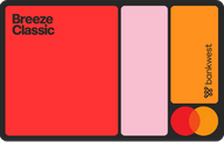What are easy approval credit cards?
An “easy approval” credit card typically refers to one with a lower minimum credit limit and simpler eligibility requirements, making it more accessible – especially for first-time cardholders.
In Australia, the easiest credit cards to get are typically the ones without high minimum credit limits or rewards programs that demand big monthly spends to unlock benefits.
The application process also matters. Some providers keep it straightforward, while others may require you to already be a customer or meet a higher minimum income, which adds an extra layer of effort.
Why are these cards easier to get approved for?
It usually comes down to the fact that these credit cards are bare-bones, with fewer features compared to premium options.
That doesn’t mean every rewards credit card or frequent flyer credit card is harder to get, but these products are generally aimed at bigger spenders who can also apply for higher credit limits.
For the bank, that means more risk if the cardholder falls behind and can’t make the minimum repayments each month.
In a nutshell: Basic, low-fee and low-rate cards have simpler eligibility criteria because they involve smaller credit exposure, attract lower-risk spending behavior, cost the bank less in perks, and have simpler eligibility criteria. Premium and rewards cards involve more financial risk for the bank, so approval criteria are typically stricter.
Types of credit cards that are easy to apply for
While no card is officially labelled “easy to get,” some types are generally simpler to qualify for.
Here’s what this term is usually referring to:
Low rate credit cards
A low rate refers to the interest rate charged on purchases that you make. Low interest credit cards have rates that range from 0% p.a. on introductory offers to about 15% p.a.
Because these cards are designed for people who may occasionally carry a balance, lenders often market them as practical “everyday” cards. That broader target market means approval criteria can sometimes be less strict compared to higher-rate cards.
No annual fee credit cards
A no annual fee credit card is one that doesn’t charge the usual yearly (or monthly) cost for keeping the card. This means you won’t pay an ongoing fee just to have it, though these cards typically offer little to no perks. In some cases, the fee waiver only applies for a limited time – such as the first 12 months – after which the annual fee kicks in.
These cards can be easier to get because the lower ongoing cost appeals to first-time applicants or those with modest incomes. Lenders view them as lower risk since the cardholder is not tied to high fees that might increase financial pressure.
Interest-free credit cards
No interest credit cards can mean a few different things: 0% interest on purchases (either ongoing or as an introductory offer), 0% on balance transfers, an extended interest-free period, or 0% on certain types of spending.
These deals are often used by banks as “entry offers” to attract new customers. Because of that, providers may make the application process more accessible, particularly if the credit limit is kept low. While these offers can save you money, they don’t mean the card is completely cost-free, as fees and conditions still apply.
Joint account credit cards
A joint credit card is held by two people, usually spouses or partners, under one account. Both names appear on the account, and both are responsible for repayments.
Joint credit cards can be easier to get approved for if one applicant doesn’t quite meet income requirements on their own but a combined household income does. This makes them a potential option for couples on lower incomes, though only a handful of lenders still offer them (i.e. Westpac).

Sean Callery, Editor of Money.com.au
"Some cards come with relatively low maximum credit limits – typically under $10,000 and as low as $500 – but the exact amount you’re approved for will be set by the card provider after assessing your application. Lenders also apply minimum income requirements to ensure applicants can manage repayments adequately. For instance, an applicant may be required to earn a minimum annual income of $30,000, while others might set the bar at $70,000. These rules strike a balance between making cards accessible for new cardholders and allowing banks to manage risk responsibly."
Sean Callery, Editor of Money.com.au
Do banks offer instant approval credit cards?
The short answer is: it depends on the applicant. Some banks and lenders advertise “instant approval” credit cards, but they still need to review your application before making a decision.
In practice, this usually means your application is processed digitally, and the bank will check certain criteria before approving or declining it (more on that below).
Even if your application is approved almost immediately – sometimes within 60 seconds – you’ll still need to wait for your account to be fully set up and for a physical card to arrive in the mail.
Some providers let you start using the card right away if they offer a virtual credit card version, which can be accessed via the banking app or a digital wallet like Google Pay.
The reality is that you still need to submit an application, even if you’re an existing customer. This typically takes 10 to 20 minutes, and in some cases, the bank may request additional information or documents to support your application.
How easy is it to get approved for a credit card?
It’s a bit like asking “how long is a piece of string?” as there’s no one-size-fits-all answer. Your approval will always come down to your financial situation. That said, your chances could be higher if you:
- Are over 18 and either an Australian citizen, permanent resident, or hold an eligible visa.
- Maintain a good credit score with a clean credit history.
- Are employed and meet the card provider’s minimum income requirement.
- Have a track record of paying bills on time.
- Apply for a card with a credit limit you can comfortably manage.
If you’ve ticked all of the above, you’ll also need to provide some standard documentation:
- Proof of identity, such as a driver’s license, passport, Medicare card, or Australian birth certificate.
- Evidence of income, like recent payslips or a letter from your employer.
- Details of your current debts and expenses, usually supported by bank statements.
There’s a good chance you’ll also need to have a mobile phone handy to receive security codes. And be ready to take a photo of your ID if requested.
Pros and cons of getting a credit card
Pros
- Can give you a financial safety net when you need it.
- Helps smooth out your cash flow.
- Earn rewards on everyday spending.
- Can help build your credit score over time.
Cons
- Having a card can make it easier to overspend.
- Interest charges can be very high (sometimes up to 29.99% p.a.) if you carry a balance after the interest-free period ends.
- Missed repayments may damage your credit score.
- Your credit limit may affect your chances of being approved for other loans.
Easy approval credit cards vs other types of finance
Here are some other fairly simple finance options and how they compare to an easy approval credit card.
Type of finance | |
Credit card | Revolving line of credit - you can borrow, repay and borrow again |
Personal loan | Lump sum borrowed and repaid in fixed installments |
Buy now pay later | Short-term installments split over weeks or months |
Interest rate | |
Credit card | Typically 10–25% p.a. |
Personal loan | Fixed or variable, usually 6–15% p.a. (can be higher for unsecured personal loans) |
Buy now pay later | 0% interest if repayments made on time, otherwise late fees may apply |
Potential fees | |
Credit card | Annual fee, late payment fees, cash advance fees, foreign exchange fees |
Personal loan | Application fee, ongoing monthly or annual fee, early repayment fee |
Buy now pay later | Usually no setup cost, but late or missed payment fees |
Credit/borrowing limit | |
Credit card | Set credit limit, often from $500 to $10,000 |
Personal loan | Based on credit score and financial position, but can range from $5,000 to $100,000+ |
Buy now pay later | Low limits, usually capped around $1,000–$5,000 depending on provider |
Easy to apply? | |
Credit card | Generally straightforward, requires credit check, proof of income and expenses |
Personal loan | Application can be more detailed, especially with a secured personal loan |
Buy now pay later | Usually very easy, often instant approval with a soft credit check |
Approval time | |
Credit card | Minutes to a few business days |
Personal loan | A few hours to several business days |
Buy now pay later | Instant or within minutes |
Typically used for | |
Credit card | Everyday spending, emergencies, travel, larger purchases |
Personal loan | Debt consolidation, car purchase, renovations, large planned expenses |
Buy now pay later | Shopping online or in-store, smaller everyday purchases |
Rewards | |
Credit card | Many cards offer rewards points, cashback or frequent flyer benefits |
Personal loan | No rewards programs |
Buy now pay later | No rewards as the focus is on flexible repayments |
Risks | |
Credit card | Overspending, high interest if balance not repaid, potential credit score impact |
Personal loan | Risk of default leading to fees or loss of asset (if secured), longer-term debt commitment |
Buy now pay later | Can encourage impulse spending, late fees add up quickly, weaker consumer protections |
| Credit card | Personal loan | Buy now pay later | |
|---|---|---|---|
Type of finance | Revolving line of credit - you can borrow, repay and borrow again | Lump sum borrowed and repaid in fixed installments | Short-term installments split over weeks or months |
Interest rate | Typically 10–25% p.a. | Fixed or variable, usually 6–15% p.a. (can be higher for unsecured personal loans) | 0% interest if repayments made on time, otherwise late fees may apply |
Potential fees | Annual fee, late payment fees, cash advance fees, foreign exchange fees | Application fee, ongoing monthly or annual fee, early repayment fee | Usually no setup cost, but late or missed payment fees |
Credit/borrowing limit | Set credit limit, often from $500 to $10,000 | Based on credit score and financial position, but can range from $5,000 to $100,000+ | Low limits, usually capped around $1,000–$5,000 depending on provider |
Easy to apply? | Generally straightforward, requires credit check, proof of income and expenses | Application can be more detailed, especially with a secured personal loan | Usually very easy, often instant approval with a soft credit check |
Approval time | Minutes to a few business days | A few hours to several business days | Instant or within minutes |
Typically used for | Everyday spending, emergencies, travel, larger purchases | Debt consolidation, car purchase, renovations, large planned expenses | Shopping online or in-store, smaller everyday purchases |
Rewards | Many cards offer rewards points, cashback or frequent flyer benefits | No rewards programs | No rewards as the focus is on flexible repayments |
Risks | Overspending, high interest if balance not repaid, potential credit score impact | Risk of default leading to fees or loss of asset (if secured), longer-term debt commitment | Can encourage impulse spending, late fees add up quickly, weaker consumer protections |










